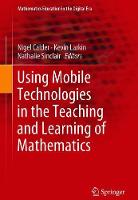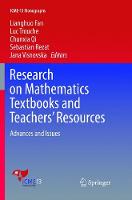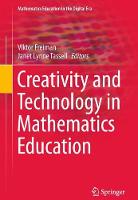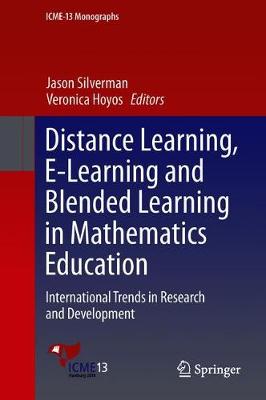Using Mobile Technologies in the Teaching and Learning of Mathematics
 -15%
portes grátis
-15%
portes grátis
Using Mobile Technologies in the Teaching and Learning of Mathematics
Calder, Nigel; Sinclair, Nathalie; Larkin, Kevin
Springer International Publishing AG
08/2018
323
Dura
Inglês
9783319901787
15 a 20 dias
664
Descrição não disponível.
01. Introduction.- 02. Mobile Technologies: How might using mobile technologies reshape the learning and teaching of mathematics? Nigel Calder, Kevin Larson and Nathalie Sinclair.- Section One: Looking across the terrain.- 03. Mathematics apps - stormy with the weather clearing: Using cluster analysis to enhance app use in mathematics classrooms. Kevin Larkin and Todd Milford.- 04. How might apps reshape the mathematical learning experience? Nigel Calder and Carol Murphy.- 05. Mobile technologies in the primary mathematics classroom: Engaging or not? Catherine Attard.- Section Two: Traversing the teaching and learning landscape.- 06. When robot A.L.E.X. trains teachers how to teach mathematics. Andreas Kyriakides and Maria Meletiou-Mavrotheris.- 07. Supporting teachers' orchestration of mobile learning activities. Hakan Sollervall, Didac Gil de la Iglesia and Janosch Zbick.- 08. Collaborative engagement through mobile technology in mathematics learning. Mina Sedaghatjou and Sheree Rodney.- 09. Augmenting mathematics with mobile technology. Christian Bokhove, Alison Clark-Wilson and Marios Pittalis.- Section Three: Navigating content: Focussing on particular concepts.- 10. Developing mastery of time concepts by integrating lessons and apps. Timothy Pelton, Todd Milford and Lesley Francis Pelton.- 11. Heatmap and hierarchical clustering analysis to highlight changes in young children's developmental progressions using virtual manipulative mathematics apps. Christina W. Lommatsch, Stephen Tucker, Patricia Moyer-Packenham and Juergen Symanzik.- 12. A better story: An embodied-design argument for generic manipulatives. Dana Rosen, Alik Palatnik, and Dor Abrahamson.- 13. Fingers-on geometry: The emergence of symmetry in a primary school classroom with multi-touch dynamic geometry. Sean Chorney and Nathalie Sinclair.- 14. Touching numbers and feeling quantities: Methodological dimensions of working with TouchCounts. Francesca Ferrara and Ketty Savioli.- 15. Approaching secondary school geometry through the logic of inquiry within technological environments. Carlotta Soldano and Ferdinando Arzarello.- Section Four: Exploring new forms of communication to make mathematical learning visible.- 16. Mathematics screencasts for teaching and learning. Linda Galligan and Carola Hobohm.- 17. The use of mobile technologies in the primary school mathematics classroom- developing 'create-alouds'. Anne Prescott and Damian Maher.- 18. Using Show and Tell apps to engage students in problem solving in the mathematics classroom. Naomi Ingram, Keryn Pratt, and Sandra Williamson-Leadley.
Este título pertence ao(s) assunto(s) indicados(s). Para ver outros títulos clique no assunto desejado.
Mobile technologies in mathematics education;Digital technologies in mathematics education;Teaching and learning of digital technologies;Conceptual understanding of mobile technologies in education;Digital games in mathematics education;Learning mathematics through mobile technologies;Influence of mobile technologies on cognition;Influence of mobile technologies on pedagogy;Influence of mobile technology on engagement;Learning with touchscreen devices;Appraising Maths Educational Apps;learning and instruction
01. Introduction.- 02. Mobile Technologies: How might using mobile technologies reshape the learning and teaching of mathematics? Nigel Calder, Kevin Larson and Nathalie Sinclair.- Section One: Looking across the terrain.- 03. Mathematics apps - stormy with the weather clearing: Using cluster analysis to enhance app use in mathematics classrooms. Kevin Larkin and Todd Milford.- 04. How might apps reshape the mathematical learning experience? Nigel Calder and Carol Murphy.- 05. Mobile technologies in the primary mathematics classroom: Engaging or not? Catherine Attard.- Section Two: Traversing the teaching and learning landscape.- 06. When robot A.L.E.X. trains teachers how to teach mathematics. Andreas Kyriakides and Maria Meletiou-Mavrotheris.- 07. Supporting teachers' orchestration of mobile learning activities. Hakan Sollervall, Didac Gil de la Iglesia and Janosch Zbick.- 08. Collaborative engagement through mobile technology in mathematics learning. Mina Sedaghatjou and Sheree Rodney.- 09. Augmenting mathematics with mobile technology. Christian Bokhove, Alison Clark-Wilson and Marios Pittalis.- Section Three: Navigating content: Focussing on particular concepts.- 10. Developing mastery of time concepts by integrating lessons and apps. Timothy Pelton, Todd Milford and Lesley Francis Pelton.- 11. Heatmap and hierarchical clustering analysis to highlight changes in young children's developmental progressions using virtual manipulative mathematics apps. Christina W. Lommatsch, Stephen Tucker, Patricia Moyer-Packenham and Juergen Symanzik.- 12. A better story: An embodied-design argument for generic manipulatives. Dana Rosen, Alik Palatnik, and Dor Abrahamson.- 13. Fingers-on geometry: The emergence of symmetry in a primary school classroom with multi-touch dynamic geometry. Sean Chorney and Nathalie Sinclair.- 14. Touching numbers and feeling quantities: Methodological dimensions of working with TouchCounts. Francesca Ferrara and Ketty Savioli.- 15. Approaching secondary school geometry through the logic of inquiry within technological environments. Carlotta Soldano and Ferdinando Arzarello.- Section Four: Exploring new forms of communication to make mathematical learning visible.- 16. Mathematics screencasts for teaching and learning. Linda Galligan and Carola Hobohm.- 17. The use of mobile technologies in the primary school mathematics classroom- developing 'create-alouds'. Anne Prescott and Damian Maher.- 18. Using Show and Tell apps to engage students in problem solving in the mathematics classroom. Naomi Ingram, Keryn Pratt, and Sandra Williamson-Leadley.
Este título pertence ao(s) assunto(s) indicados(s). Para ver outros títulos clique no assunto desejado.
Mobile technologies in mathematics education;Digital technologies in mathematics education;Teaching and learning of digital technologies;Conceptual understanding of mobile technologies in education;Digital games in mathematics education;Learning mathematics through mobile technologies;Influence of mobile technologies on cognition;Influence of mobile technologies on pedagogy;Influence of mobile technology on engagement;Learning with touchscreen devices;Appraising Maths Educational Apps;learning and instruction







